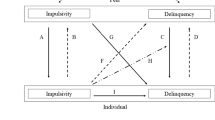Abstract
A large number of delinquent activities are performed by adolescents and only occur during this period in their lives. One of the main factors that influence this behaviour is social interaction, mainly with peers. This paper contributes a computational model that predicts delinquent behaviour during adolescence based on interaction with friends and classmates. Based on the model, which was validated based on empirical data, the level of delinquency of pupils is simulated over time. Furthermore, simulation experiments are performed to investigate for hypothetical scenarios what is the impact of the division of students over classes on the (individual and collective) level of delinquency.
Access this chapter
Tax calculation will be finalised at checkout
Purchases are for personal use only
Preview
Unable to display preview. Download preview PDF.
Similar content being viewed by others
References
Bosse, T., Gerritsen, C., Klein, M.C.A.: Agent-Based Simulation of Social Learning in Criminology. In: Proc. of the Int. Conf. on Agents and AI, ICAART 2009, pp. 5–13. INSTICC Press (2009)
Bosse, T., Gerritsen, C., Klein, M.C.A., Weerman, F.M.: Development and Validation of an Agent-Based Simulation Model of Juvenile Delinquency. In: Proc. of the Int. Symposium on Social Intelligence and Networking, SIN 2009, pp. 200–207. IEEE Computer Society Press, Los Alamitos (2009)
Davidsson, P.: Agent Based Social Simulation: A Computer Science View. Journal of Artificial Societies and Social Simulation 5(1) (2002)
Gottfredson, M., Hirschi, T.: A General Theory of Crime. Stanford University Press (1990)
Green, D.M., Swets, J.A.: Signal Detection Theory and Psychophysics. Wiley, NY (1966)
Hosmer, D., Lemeshow, S.: Applied logistic Regression. John Wiley & Sons, NY (2000)
Liu, L., Wang, X., Eck, J., Liang, J.: Simulating Crime Events and Crime Patterns in RA/CA Model. In: Wang, F. (ed.) Geographic Information Systems and Crime Analysis, pp. 197–213. Idea Group, Singapore (2005)
Matsueda, R.L., Anderson, K.: The dynamics of delinquent peers and delinquent behaviour. Criminology 36, 269–308 (1998)
Melo, A., Belchior, M., Furtado, V.: Analyzing Police Patrol Routes by Simulating the Physical Reorganisation of Agents. In: Sichman, J.S., Antunes, L. (eds.) MABS 2005. LNCS (LNAI), vol. 3891, pp. 99–114. Springer, Heidelberg (2006)
Moffitt, T.E.: Adolescence-Limited and Life-Course-Persistent Antisocial Behavior: A Developmental Taxonomy. Psych. Review 100(4), 674–701 (1993)
Sutherland, E.H., Cressey, D.R.: Principles of Criminology, 7th edn. J.B. Lippincott, Philadelphia (1966)
Warr, M.: Companions in Crime. The social aspects of criminal conduct. Cambridge University Press, Cambridge (2002)
Weerman, F.M., Bijleveld, C.C.J.H.: Birds of Different Feathers. European Journal of Criminology 4(4), 357–383 (2007)
Weerman, F.M., Smeenk, W., Harland, P. (eds.): Problem behavior of students during secondary education: Individual development, student networks and reactions from school (in Dutch). Aksant, Amsterdam (2007)
Author information
Authors and Affiliations
Editor information
Editors and Affiliations
Rights and permissions
Copyright information
© 2010 Springer-Verlag Berlin Heidelberg
About this paper
Cite this paper
Bosse, T., Gerritsen, C., Klein, M.C.A. (2010). Predicting the Development of Juvenile Delinquency by Simulation. In: García-Pedrajas, N., Herrera, F., Fyfe, C., Benítez, J.M., Ali, M. (eds) Trends in Applied Intelligent Systems. IEA/AIE 2010. Lecture Notes in Computer Science(), vol 6097. Springer, Berlin, Heidelberg. https://doi.org/10.1007/978-3-642-13025-0_58
Download citation
DOI: https://doi.org/10.1007/978-3-642-13025-0_58
Publisher Name: Springer, Berlin, Heidelberg
Print ISBN: 978-3-642-13024-3
Online ISBN: 978-3-642-13025-0
eBook Packages: Computer ScienceComputer Science (R0)




